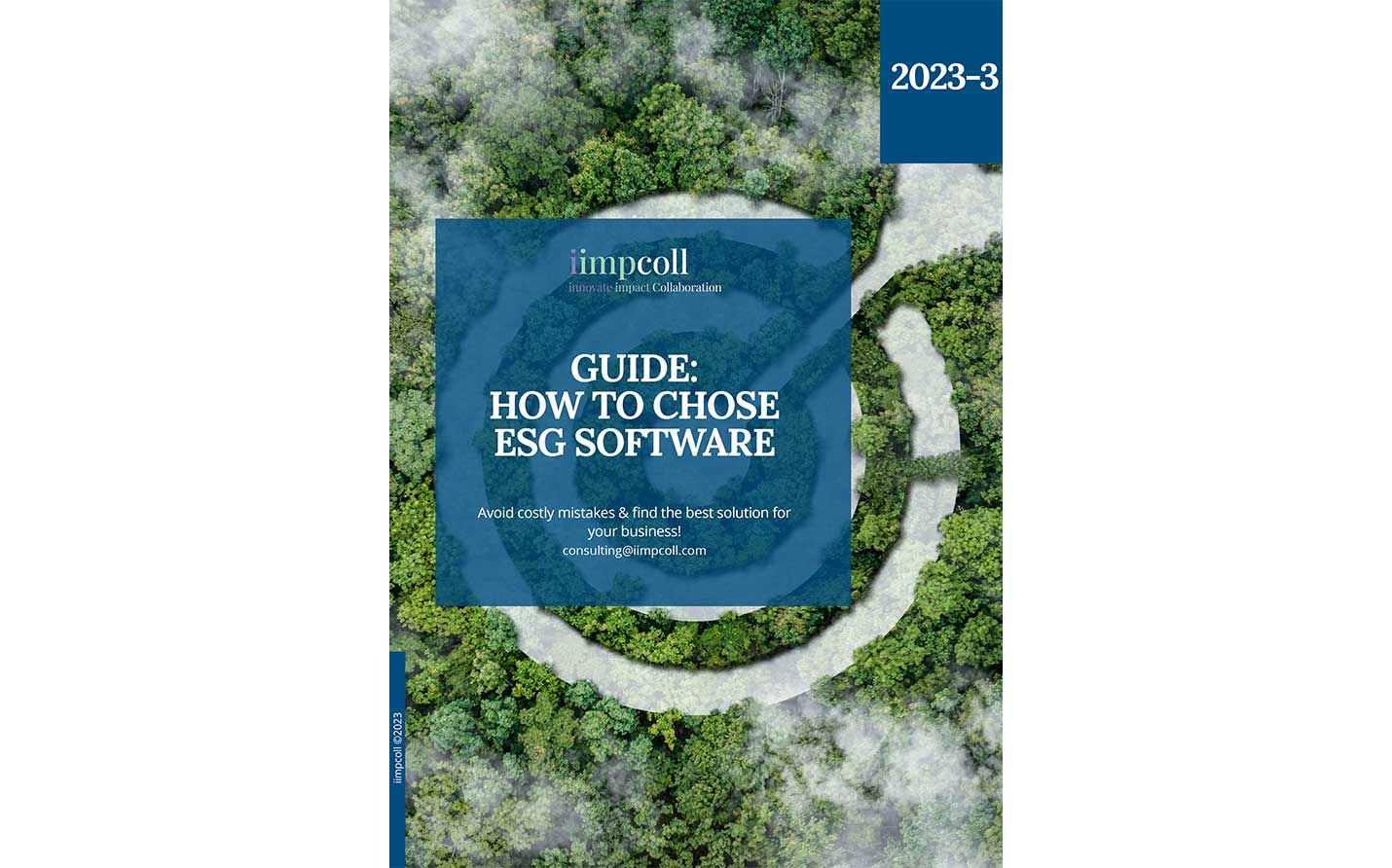What are ESG frameworks and standards?

Anna Zakrisson
CSO at iimpcoll
2023-10-04
15 min


ESG reporting plays a vital role in promoting transparency by facilitating the disclosure of an organization's environmental, social, and governance initiatives and data.
Incorporating ESG frameworks and standards is essential in guiding sustainability efforts and streamlining the reporting process. However, navigating the intricate landscape of ESG frameworks and standards can be daunting.
Your standards/framework selection should consider factors such as operating location, sector, organizational complexity, size, and other relevant considerations.
Need help?
We, at iimpcoll, provide expert guidance and advice all along your value chain. CONTACT US TODAY!
ESG reporting frameworks & standards: essential tools for transparent and responsible businesses
Responsible businesses are now facing closer scrutiny in terms of how they account for their sustainability performance. To overcome greenwashing, there is a growing need for clear sustainability standards. However, there is often misinformation surrounding the distinctions between standards, frameworks, rankings, and ratings, including their different approaches and purposes.
This article offers an overview of the most relevant ESG frameworks and standards, including the European Corporate Sustainability Reporting Directive and the European Sustainability Reporting Standards, providing useful descriptions and links for further exploration. First, let’s start by clarifying a few key concepts, such as “What is the difference between a framework and a standard?”.
Use our FREE ESG software tool! There are more than 150 ESG software solutions on the market. Get the right one and only pay for what you need! TAKE ME TO THE TOOL
ESG frameworks vs. ESG standards
Navigating the world of ESG (Environmental, Social, and Governance) can be overwhelming due to the numerous frameworks and standards available. Understanding this complex landscape is crucial for organizations to effectively convey their sustainability efforts. ESG reporting encompasses both frameworks and standards, each serving a specific purpose.
Frameworks provide guidance on structuring and collecting information, focusing on principles that cover a wide range of topics. They ensure a comprehensive approach to ESG reporting, allowing organizations to contextualize information and shape their thoughts on the subject.
On the other hand, standards offer specific requirements and metrics for reporting, serving as agreed-level quality requirements. Standards provide clear reporting instructions, ensuring consistency and comparability in ESG disclosures. They act as detailed criteria or metrics for reporting on each topic.
By incorporating both frameworks and standards together, organizations can create meaningful and comprehensive ESG reports. This approach allows for individual documents to make sense and enables effective comparison with others.
Voluntary vs. mandated ESG reporting
ESG reporting is gaining momentum as organizations recognize the increasing interest from investors and communities. It has become a mainstream practice, and organizations are often expected to disclose their ESG performance. Neglecting ESG risks can have severe consequences, such as shareholder action, divestment, and often also legal repercussions.
Voluntary disclosure frameworks and guidance frameworks provide platforms, methodologies, and metrics for reporting ESG performance. Government mandates on sustainability and ESG disclosures are also emerging, such as the European Union's Corporate Sustainability Reporting Directive (first reports to be done by 2024) and the U.S. Securities and Exchange Commission's proposed climate risk disclosure rule.
How to decide which ESG frameworks to use
If you are operating within the EU, the choice is easy as you are (or soon will be, depending on, e.g., organizational size) required to be CSRD compliant and report according to the ESRS standards (or use the GRI standards that are aligned with ESRS for the impact materiality-part).
Choosing the right ESG reporting framework can be a daunting task, given the multitude of options available. To make informed decisions, start by assessing your industry and examining frameworks commonly used by companies in your field. Additionally, consider your competitors' choices for benchmarking purposes.
Take into account the preferences and informational needs of stakeholders, such as investors, customers, and employees. Furthermore, stay updated on emerging regulations, particularly those related to climate disclosures and ESG reporting. To streamline your decision-making process, evaluate and categorize frameworks from various perspectives. This approach will provide clarity and help you select the most suitable ESG reporting framework for your specific requirements.
Keep in mind that the ESG framework landscape is dynamic and continuously evolving, with some standards still in development, which can sometimes be confusing.
What to assess before selecting your ESG framework:
- Geography & jurisdiction
- Materiality – potential for impact
- Stakeholder expectations & requirements
- Sector preferences
- ESG framework topic coverage
Geography & jurisdiction
Certain ESG reporting frameworks are only relevant in specific locations and legal jurisdictions. In some cases, this is because reporting is mandated by local law. In others, it can be because the framework is specific to local conditions. One example of a framework that is mandated by law is the European Corporate Sustainability Reporting Directive for organizations that operate within the EU.
Materiality - potential for impact
When considering the choice of a reporting framework, organizations should first assess where they can have the greatest impact based on materiality assessments. Materiality, in the context of Environmental, Social, and Governance (ESG), guides organizations to prioritize relevant ESG issues that will measurably affect their business. By applying a "risk matrix" approach, organizations can prioritize ESG-related risks according to their risk profile and identify significant negative impacts on the organization.
Assessing double materiality involves organizations considering materiality from two perspectives: financial materiality and materiality to the market, environment, and people. This concept acknowledges that an organization is accountable for managing its own financial risks internally while also examining the external impacts of its decisions and operations on people and the environment. By incorporating the concept of double materiality, organizations can identify both financial and nonfinancial impacts, helping to shape a comprehensive ESG strategy. Double materiality is a requirement under CSRD.
Additionally, organizations should consider impact and influence when assessing their ESG reporting approach, focusing on the environmental and social factors they can directly and swiftly influence. Effective prioritization is crucial for organizations striving to make a meaningful impact. One such approach is the use of an action priority or impact effort prioritization matrix which enables companies to swiftly identify key areas where they should focus their initial efforts. This, in turn, enables the selection of an Environmental, Social, and Governance (ESG) framework that aligns with attainable goals.
Notably, companies in the fast-moving consumer goods and retail sectors wield significant influence in their supply chain, with procurement choices impacting the overall ESG performance of supply chain companies.
If you want to learn more about Materiality and Double Materiality, download our whitepaper: An easy guide to materiality! …and check out our blog article: How to do a materiality assessment
Stakeholder expectations & requirements
Stakeholder expectations in ESG reporting are crucial considerations for organizations. When exploring frameworks, it is important to evaluate stakeholder expectations specific to preferred ESG reporting frameworks and how they will use the disclosed information. External stakeholders such as investors, boards, insurers, and creditors may prefer reports aligned with the Task Force on Climate-related Financial Disclosures (TCFD) or the Sustainability Accounting Standards Board (SASB).
On the other hand, employees and consumers may expect disclosures based on the United Nations Sustainable Development Goals (UN SDGs), while local governments or regulators may prioritize frameworks such as the UK Streamlined Energy and Carbon Reporting (SECR) or the Australian National Greenhouse and Energy Reporting (NGER), depending on the jurisdiction.
Considering how internal stakeholders will utilize this information is equally important. Data on ESG disclosures can drive strategic decisions around equity, inclusion, and risk assessment for risk, compliance, and HR teams. Energy and utilities teams will closely examine consumption and expenditure across the organization. Procurement teams will use the disclosed data to evaluate supply chain operations and assess the risk profile of suppliers.
Sector preference
In the world of sustainability reporting frameworks, organizations within a specific sector often discover a natural alignment with certain frameworks. One such framework is the Global Real Estate Sustainability Benchmark (GRESB), which assesses the sustainability performance of real estate and infrastructure portfolios.
For organizations seeking to evaluate which frameworks their peers utilize, valuable information can be found on the websites of reporting frameworks themselves. These sites typically offer sector filters and lists of reporters, enabling organizations to determine the applicability of specific ESG frameworks to their own sector.
Moreover, organizations can glean insights from their sector peers' websites, where published sustainability reports and annual reports can shed light on how others have approached reporting within relevant frameworks.
ESG framework topic coverage
ESG frameworks encompass a broad spectrum of topics, including climate change, human rights, labor standards, data privacy, board diversity, and executive compensation. Each framework has its unique topics and performance indicators.
Examples of ESG Frameworks
Corporate Sustainability Reporting Directive (CSRD)
On April 21, 2021, the European Commission announced the adoption of the Corporate Sustainability Reporting Directive (CSRD) in alignment with the commitment made under the European Green Deal. The CSRD replaces the existing Non-Financial Reporting Directive (NFRD) and significantly enhance reporting obligations for companies falling within its scope, aiming to extend sustainability information for stakeholders. This development marks a crucial step towards promoting transparency and accountability in corporate sustainability practices, fostering a more sustainable and responsible business environment.
The EU’s Corporate Sustainability Reporting Directive (CSRD) sets out regulations for organizations to disclose sustainability information across various environmental and social topics. It requires companies subject to the CSRD to report according to the European Sustainability Reporting Standards (ESRS). The CSRD considers both financial and societal impacts, emphasizing the importance of mitigating risks related to environmental and social issues through a transparent business strategy.
A key aspect of the CSRD is its inclusion of social metrics in addition to environmental performance. It assesses factors such as employee health, human rights, bribery, anti-corruption, and diversity within management.
The CSRD currently (2023) applies to organizations meeting certain criteria: total assets exceeding €20 million, net turnover of €40 million, and/or employing 250 or more individuals. This includes both EU companies and EU subsidiaries of non-EU companies, affecting over 50,000 businesses, with approximately 10,000 of them being located outside the EU.
Non-European companies generating an annual net turnover of €150 million within the EU and having at least one subsidiary or branch in the EU are also required to report on sustainability. Compliance for non-EU companies will be mandatory starting from 2028.
How does the CSRD work?
The double materiality assessment is a crucial aspect of CSRD reporting, significantly influencing the reporting scope. However, executing this assessment can be more intricate than traditional impact materiality assessments (such as GRI-based assessments). It necessitates that companies identify their impacts on both people and the environment (impact materiality) as well as sustainability issues that financially affect the business (financial materiality).
Another requirement of CSRD is the establishment of targets, selection of a baseline, and reporting the progress made toward those targets. Additionally, the disclosed information should include both forward-looking and retrospective data, broadening the scope to cover the entire value chain.
It is important to note that the ESRS entails reporting in line with the EU Taxonomy. From the beginning, limited assurance is mandatory, potentially evolving into reasonable assurance requirements in the future.
Furthermore, the CSRD mandates the disclosure of sustainability information in the Management Report. This may necessitate restructuring the existing report format to accommodate new and diverse types of information.
Companies are also expected to align their reporting with the Task Force on Climate-related Financial Disclosures (TCFD) on supporting the transition to a sustainable economy, limiting global warming to 1.5°C, and aiming for climate neutrality by 2050.
To comply with all CSRD requirements, companies should acquire and integrate sustainability (technical reporting) knowledge within their organization.
What is the Global Reporting Initiative (GRI) framework?
The Global Reporting Initiative (GRI) is an internationally recognized framework and standards organization that helps businesses, governments, and organizations understand and communicate their impacts on critical issues such as climate change, human rights, and corruption.
The GRI Standards' sustainability reporting framework has emerged as the world's most widely adopted framework. Many companies, under increasing pressure from governments, consumers, and investors, publish sustainability reports, also known as corporate social responsibility (CSR) or environmental, social, and governance (ESG) reports. GRI's framework enables companies to identify, gather, and report this information in a clear and comparable manner.
How does the GRI framework work?
The GRI framework is made up of modular standards. Hence, we have added a paragraph about GRI under both “Frameworks” and “Standards”.
The GRI Standards are designed with a modular structure, allowing for easier updates and adaptations. They consist of three series of Standards: Universal Standards, Sector Standards, and Topic Standards.
The Universal Standards apply to all organizations and cover core sustainability issues related to a company's impact on the economy, society, and the environment.
The Sector Standards are tailored to specific sectors, especially those with significant environmental impact, such as fossil fuels.
Lastly, the Topic Standards provide a list of disclosures relevant to specific areas of focus.
The GRI Standards and reporting criteria are reviewed every three years by the Global Sustainability Standards Board (GSSB), an independent body established by GRI. As of 2023, not all Sector Standards have been published.
What is the Carbon Disclosure Project (CDP)?
CDP, short for the Carbon Disclosure Project, is a non-profit founded in 2000 to promote environmental disclosure. They offer a reporting system for companies to communicate climate change, water security, and deforestation risks and opportunities. CDP collects environmental data and assigns letter-grade scores to companies, enabling stakeholders to assess their sustainability efforts.
To enhance sustainability practices, CDP recently released its 2022 reporting guidance. The revised questionnaires include expanded governance inquiries and assess a company's capabilities in managing climate, water, and forest risks while prioritizing biodiversity.
One aspect of the CDP questionnaire is the request for detailed information on transition strategies and projected expenses to achieve net-zero emissions by 2050. By providing comprehensive data, businesses demonstrate their commitment to sustainable operations and align with sustainability goals.
CDP reporting has implications for businesses as stakeholders demand environmental responsibility. Adhering to CDP guidelines helps companies meet sustainability standards and develop carbon reduction targets.
How does the CDP work?
CDP offers questionnaires and assessments on critical environmental issues such as climate change, water security, and deforestation. With these assessments conducted by accredited partners, businesses, cities, and governments can evaluate and address risks effectively. The comprehensive reporting process involves data gathering, completion of questionnaires, and assessment by qualified partners.
CDP's Activity Classification System (CDP-ACS) categorizes companies based on specific sectors and assigns sector-specific questions, allowing businesses to understand the implications of climate change, water security, and deforestation. The questionnaire evaluates organizations based on governance, risks and opportunities, business strategy, targets and performance, stakeholder engagement, and the value chain. Letter grades from A to D- are assigned to measure environmental performance and progress toward actionable change, providing companies with a competitive edge. Achieving high scores may lead to inclusion on the esteemed A-List.
Participating companies gain access to a user-friendly dashboard and Online Reporting System (ORS). The reporting deadline in July allows them around seven months to calculate carbon emissions, complete the questionnaire, and review their submissions. CDP is aligned with the Task Force on Climate-related Financial Disclosures’ (TCFD) recommendations.
Task Force on Climate-related Financial Disclosures (TCFD)
The TCFD helps organizations worldwide articulate how ESG performance will likely impact future financial performance and value creation.
The TCFD was created in December 2015 following the request of the G20 Finance Ministers for the Financial Stability Board (FSB) to evaluate the link between climate-related issues and the financial sector. As an international body that advises the global financial system, the FSB played a significant role in driving climate-related finance.
The TCFD's main objective is to develop recommendations for companies to disclose climate-change-related financial risks. Released in 2017, the TCFD's 11 recommendations revolve around governance, strategy, risk management, and climate-related metrics and targets. Over 4,000 companies have expressed their support for these recommendations. Additionally, several countries have mandated reporting aligned with the TCFD's guidelines, and the proposed rule by the SEC for climate-related risk disclosures of U.S. companies is also aligned with TCFD recommendations.
How does the TCFD Framework function?
The TCFD Framework consists of four pillars, addressing the following disclosure requirements related to climate risks:
- Governance: How does the organization's governance structure handle climate-related risks and opportunities?
- Strategy: What are the tangible and material impacts of climate-related risks and opportunities on the entire business, including strategy and financial planning?
- Risk management: How does the organization define, evaluate, and handle risks associated with climate?
- Metrics and targets: What measurements are used to assess material climate-related risks and opportunities?
Value Reporting Foundation (VRF) by the Sustainability Accounting Standards Board (SASB) and International Integrated Reporting Council (IIRC)
The Sustainability Accounting Standards Board (SASB) and the International Integrated Reporting Council (IIRC) merged in 2021, to establish the Value Reporting Foundation (VRF). This newly formed entity represents an ESG guidance framework that aims to establish standards for financially material sustainability disclosures by companies to their investors. Among the resources they provide include the Integrated Thinking Principles, the Integrated Reporting Framework, and SASB Standards.
With a comprehensive coverage of 77 industry standards, the SASB Standards effectively monitor ESG issues and performance. Companies can rely on the VRF's framework to effectively communicate their significant ESG impacts to investors, debt holders, and internal financial stakeholders.
How the SASB work?
Of the other ESG reporting frameworks, the GRI is most like SASB but supplies more broadly material information for reporting to stakeholders who are not just from financial portfolios.
SASB operates with a set of core principles that guide its approach to standard setting, as defined in its Conceptual Framework. These principles are designed to facilitate sustainability disclosures that provide material, decision-useful information to investors and are cost-effective for reporting companies.
One of the key principles that SASB emphasizes is global applicability. According to SASB's mission statement, investor-focused sustainability information should be relevant, reliable, and comparable across companies on a global basis. SASB ensures that more than three-quarters of its metrics are appropriate for use globally, with the remaining metrics under review for enhanced global applicability.
Another important principle for SASB is financial materiality. The SASB Standards are specifically geared towards providing decision-useful information to investors. The standards are investor-driven and focus on financially material issues that matter most to investors. This emphasis on financial materiality sets SASB apart from other sustainability reporting standards, such as the Global Reporting Initiative (GRI), which considers a company's impacts on the broader economy, environment, and society to determine its material issues.
What is the United Nations Global Compact?
United Nations Global Compact is a corporate sustainability initiative that was formed in 2000. It is known as the "world's largest" and focuses on aligning business strategies with 10 principles encompassing human rights, labor practices, the environment, and anti-corruption measures.
Participating companies must provide an annual Communication on Progress (CoP) report that outlines their commitment to the principles. To date, over 47,000 CoP reports have been submitted. The Global Compact has introduced a new digital platform for CoP submissions, replacing the initial narrative style with a standardized questionnaire, which was introduced in 2023. This digital transformation streamlines the reporting process and improves efficiency.
Furthermore, businesses have the opportunity to report their contribution to and impact on the United Nations' broader Sustainable Development Goals. This can be done through a separate platform that combines the principles of the Global Compact and the GRI Standards .
What is the Workforce Disclosure Initiative?
Workforce Disclosure Initiative was created in 2016 by ShareAction, a charity that supports responsible investment practices with an ESG focus. The Workforce Disclosure Initiative (WDI) offers a comprehensive platform for reporting data on workforce practices and management. It is modeled after the disclosure system of CDP and sets the benchmark for transparency in disclosing company workforce data.
What sets WDI apart is its unique scope and ambition, covering ten crucial workforce management aspects such as governance, risk assessment, contractual status and remuneration, gender diversity, stability, training, and rights issues. Regardless of the corporate sector or geographical region, the WDI survey applies to all, making it an invaluable tool for companies looking to improve their workforce reporting.
Since its inception in 2017, WDI has gained support from 140 institutional investors and established international partnerships in Canada and Australia. Notably, 118 of the largest listed companies worldwide have embraced WDI's platform, making significant strides in enhancing corporate workforce reporting.
What is Streamlined Energy and Carbon Reporting (SECR)?
The Streamlined Energy and Carbon Reporting (SECR) taxonomy is the UK government's comprehensive guidance for organizations obligated to disclose energy consumption, greenhouse gas (GHG) emissions, and associated details. Introduced on April 1, 2019, as a successor to the Carbon Reduction Commitment (CRC) Energy Efficiency Scheme, SECR builds upon previous reporting obligations for publicly traded companies while adding new requirements for large unquoted companies and limited liability partnerships (LLPs).
Apart from mandatory reporting, SECR also assists organizations in voluntary reporting across various environmental topics, encompassing GHG reporting and key performance indicators (KPIs). It plays a crucial role in the UK's strategy to enhance energy efficiency and mitigate CO2 emissions, aligning with the Climate Change Act 2008.
How the SECR works
Companies reporting to the SECR must disclose their energy usage, global Scope 1 and 2 GHG emissions (in metric tons of CO2e), and at least one emissions intensity metric for the current and previous financial years. While reporting Scope 3 emissions is voluntary, it is recommended for emissions sources deemed material. This requirement extends to unquoted large companies and LLPs, who are obligated to report their UK energy usage, associated GHG emissions from electricity, gas, and transport fuels, as well as at least one intensity metric.
What is Sustainable Finance Disclosure Regulation (SFDR)?
The Sustainable Finance Disclosure Regulation (SFDR) is a crucial European regulation that aims to enhance transparency in the market for sustainable investment products, combat greenwashing, and improve transparency around sustainability claims by financial market participants. It imposes comprehensive sustainability disclosure requirements covering a wide range of environmental, social, and governance (ESG) metrics at both the entity and product level.
The SFDR, which came into effect on 10 March 2021, is a fundamental pillar of the EU Sustainable Finance agenda. Alongside the Taxonomy Regulation and the Low Carbon Benchmarks Regulation, it was introduced by the European Commission as part of its 2018 Sustainable Finance Action Plan.
How does SFDR work?
The Sustainable Finance Disclosure Regulation (SFDR) is a pivotal measure aiming to create a level playing field among financial market participants and advisors. It focuses on enhancing transparency regarding sustainability risks, integrating adverse sustainability impacts in investment processes, and providing sustainability-related information for financial products. This mandatory disclosure requirement applies to all asset managers, irrespective of their explicit focus on environmental, social, and governance (ESG) or sustainability. Under SFDR, asset managers are obligated to furnish standardized and prescribed disclosures on the integration of ESG factors at both the entity and product levels.
In conjunction with the EU taxonomy and the EU Corporate Sustainability Reporting Directive (CSRD), SFDR plays a crucial role in advancing the EU's sustainable finance agenda. By standardizing ESG metric reporting for financial products and entities, SFDR contributes to fostering sustainability and transparency in the European financial market. It further reinforces the significance of responsible investing and the integration of ESG factors.
SFDR's Public Accountability Statement requires organizations to report various quantitative indicators, including weighted averages of ESG metrics for investments and emissions from their own activities. Additionally, organizations must disclose the proportion of their investees' activities that they finance. For instance, if an investee generates 100 metric tons of hazardous waste and the financial institution holds a 20% equity stake, the institution would report 20 metric tons of hazardous waste in its SFDR Public Accountability Statement (PAI).
What is National Greenhouse and Energy Reporting (NGER)?
The National Greenhouse and Energy Reporting (NGER) scheme, established under the Australian National Greenhouse and Energy Reporting Act 2007 (NGER Act), plays a crucial role in Australia's efforts to manage greenhouse gas emissions and energy consumption. Administered by the Clean Energy Regulator (CER), this national legislative framework requires corporations to report on their greenhouse gas emissions, energy production, and energy consumption.
By streamlining reporting requirements and ensuring compliance, the NGER scheme not only informs government policy and supports various programs and activities but also provides valuable information to the Australian public. Through the Emissions and Energy Reporting System (EERS), corporations submit their reports, which are then monitored and audited by the CER.
The NGER scheme serves as a cornerstone for reporting and publishing company information about greenhouse gas emissions and energy-related activities. It helps Australia meet its international reporting obligations while avoiding duplication of similar requirements at the state and territory level. With over 400 entities currently reporting annually, the NGER Act focuses on high-emitting sectors such as energy production, transportation, agriculture, and industrial processes.
By promoting transparency and accountability, the NGER scheme supports Australia's commitment to addressing climate change and fostering sustainable practices.
How does NGER work?
The NGER Scheme collects emissions-related data for GHGs such as carbon dioxide (CO2), methane (CH4), nitrous oxide (N2O), sulfur hexafluoride (SF6), and specific types of hydrofluorocarbons and perfluorocarbons. Records of activities must enable the Clean Energy Regulator to verify compliance with obligations under the NGER Act. This includes information for external audits that establish the relevance, completeness, consistency, transparency, and accuracy of reported data.
What is the Global Real Estate Sustainability Benchmark (GRESB)?
The Global Real Estate Sustainability Benchmark (GRESB), established in 2009 by real estate fund holders, is a widely utilized global tool for evaluating the sustainability performance of real estate and infrastructure portfolios worldwide. With a focus on environmental, social, and governance (ESG) benchmarks, GRESB facilitates access to reliable and comparable data, providing participants with insights into their standing relative to their peers. This helps investors take informed action to enhance their ESG performance while offering a communication platform for engaging with investors. The assessment, conducted in the categories of Management, Performance, and Development, yields benchmark reports publicly available on GRESB's website.
How does GRESB work?
GRESB Assessments provide valuable insights into the sustainability performance of companies' real assets, catering to investors and asset managers. Aligned with global reporting frameworks like the GRI and PRI, these assessments offer comparative business intelligence and actionable steps to enhance ESG performance. Acting as a communication platform for engaging with investors, GRESB equips them with ESG data and tools to bolster the sustainability of their investment portfolios. By utilizing benchmark ESG frameworks, companies effectively measure and improve their sustainability practices.
In addition to the real estate sector, GRESB has expanded to include infrastructure investments. The organization incorporates data from various international green building certification programs, such as the BREEAM, recognizing the increasing importance of sustainability. Voluntary frameworks, like the GRI, offer flexibility to reporters, allowing them to select industry-specific questions based on materiality. GRI Standards consist of modular and interconnected components, forming a comprehensive sustainability report that focuses on material topics. Organizations reporting under the GRI framework utilize the three universal standards and select topic-specific standards for aspects like economics, environment, and social factors.
GRESB participants can upload asset data to ARC to identify potential certifications and enhance their ESG ratings while comparing properties within their portfolio. The results are benchmarked against a peer group based on country, location, usage, and impact on building operation, aiming to achieve the "Green Star" rating.
What is the CDSB Framework?
CDSB Framework, developed by the Climate Disclosure Standards Board (CDSB), the CDSB Framework supports ESG reporting in mainstream corporate reports, including annual reports and 10-K filings. The framework's first version, released in 2010, initially focused on climate change issues.
An update was introduced in 2015 to incorporate broader environmental reporting, followed by another update in 2022 that added information on ESG's social factors. According to the CDSB's website, the framework was utilized by 374 companies in 32 countries at its peak.
Although still usable for now, no further development is planned as the CDSB has consolidated into the IFRS Foundation as of 2022.


Which ESG standards are there?
What are the European Sustainability Reporting Standards (ESRS)?
The ESRS standards are an integral part of the CSRD, the Corporate Sustainability Reporting Directive of the European Parliament, and the Council and play a crucial role in promoting sustainable practices and transparency in companies within the EU. The adoption of the initial set of 12 standards by the Commission marks a significant milestone towards advancing corporate sustainability reporting and ensuring comparability among approximately 50,000 EU-based companies. Additionally, the impact of these standards extends to subsidiaries, branches abroad, and companies with substantial business activities in the EU, amplifying their significance.
The ESRS standards aim to enhance the scope and quality of corporate sustainability reporting, providing stakeholders, including investors, other companies, and society, with valuable insights into the business practices of the reporting companies. Companies are compelled to delve deeper into their sustainability performance through rigorous requirements, extending from their supply chain to the end of the product life cycle. By incorporating qualitative and quantitative ESRS indicators and reliable information on sustainability performance, companies are faced with increased obligations, necessitating robust data management and reporting structures. Notably, the CSRD facilitates electronic reporting of sustainability data.
Under the CSRD, companies subject to its coverage are not required to produce a separate sustainability report in accordance with ESRS standards. Instead, sustainability information has been integrated into the group's annual report, bolstered by external audit requirements. Companies are expected to provide explanations on the collection of ESRS Environmental, Social, and Governance (ESG) data and the calculation of ESRS Key Performance Indicators (KPIs). Consequently, sustainability disclosures have attained a heightened level of importance, paralleling other reportable information within financial reporting.
The initial collection of ESRS, referred to as the "first set," comprises two cross-cutting standards and ten topical standards. Each standard addresses critical aspects of sustainability, covering environmental, social, and governance areas (ESRS ESG). This comprehensive framework ensures a streamlined and coherent structure for presenting sustainability information.
What is the Global Reporting Initiative (GRI) standards?
GRI Standards. According to its website, the standards developed by the Global Reporting Initiative (GRI) allow any organization - regardless of size or nature - to comprehensively assess and communicate their environmental, socioeconomic, and other societal impacts. The GRI Standards offer a modular framework consisting of universal, sector-specific, and topic-based sustainability reporting standards.
Originally known as the GRI Guidelines, when first published in 2000, the formal standards were introduced by GRI in 2016. Subsequently, topic standards were added in 2019, followed by sector-specific ones in 2021. However, not all sector standards have been published by 2023. In addition to reporting companies, the relevance of these standards extends to investors, policymakers, and other stakeholders.
What are the IFRS Sustainability Disclosure Standards?
IFRS Sustainability Disclosure Standards, were developed by the International Sustainability Standards Board (ISSB) under the International Financial Reporting Standards (IFRS) Foundation. These standards, which supersede the CDSB Framework, aim to provide a unified global approach to reporting environmental, social, and governance (ESG) data to investors.
The ISSB is currently focused on creating two sets of requirements that cover general sustainability-related financial information and specific climate-related risks and opportunities. In June 2023, the organization unveiled the initial version of both standards, marking a significant milestone.
What are the SASB standards?
SASB Standards were originally developed by the Sustainability Accounting Standards Board and released in 2018. These standards contain specifications for disclosing financial material sustainability information across 77 industries.
The framework includes subsets of relevant ESG issues for each industry, including markets for different IT products and services. In a recent survey conducted by TechTarget's Enterprise Strategy Group division, which involved 400 IT professionals, SASB was the top choice among 66% of the respondents for evaluating the ESG programs of IT suppliers.
However, in 2021, SASB was consolidated into the Value Reporting Foundation, which has since been absorbed by the IFRS Foundation in 2022. Although the IFRS Foundation plans to replace SASB Standards with its new standards in the future, they are currently still available for use.
What is ISO26000?
ISO 26000:2010 is a globally recognized standard that provides guidelines for social responsibility, commonly referred to as CSR (corporate social responsibility). Published by ISO on November 1, 2010, it aims to promote social responsibility practices among organizations, enhancing their impact on workers, the environment, and communities.
The Seven Key Principles, regarded as the cornerstone of socially responsible conduct, encompass accountability, transparency, ethical behavior, stakeholder interests, adherence to the rule of law, international behavioral norms, and human rights. ISO 26000's Seven Core Subjects encompass organizational governance, human rights, labor practices, environmental considerations, fair operating practices, consumer concerns, and community involvement. This standard offers comprehensive guidance on engaging stakeholders, identifying issues, and fostering effective communication.
It's important to note that ISO 26000 is not intended for management system certification or regulatory purposes. Falsely claiming certification to ISO 26000 would misrepresent its intended use. Furthermore, it should not be utilized as a basis for audits, conformity assessments, certification, or compliance statements. Its primary value lies in expressing the CEO's commitment to social responsibility.
How to select ESG software
ESG reporting is becoming increasingly important as the investor community focuses more on ESG metrics and closely examines this data. Unlike financial data, ESG data often (historically) lacks accuracy and is stored in different systems or unreliable spreadsheets. This is inefficient, especially for complex organizations reporting to multiple frameworks under stakeholder and regulatory pressure.
To address these challenges, organizations can implement specialized ESG reporting software platforms. These platforms can capture activity data, calculate emissions, and manage sustainability initiatives, improving ESG reporting.
The environmental aspect (the "E" in ESG) is particularly challenging to report and track, making accurate reporting and tracking essential for organizations aiming to reduce carbon emissions. Regardless of the chosen framework, accurate, automated, and auditable ESG reporting practices are crucial.
Adopting specialized ESG reporting solutions allows organizations to navigate the changing ESG landscape effectively. ESG reporting software streamlines the process by automating data capture from reliable sources and maintaining an emissions factor engine with recognized carbon emissions factor data tables such as those from the European Environment Agency, US EPA Climate Leaders Program, and the IPCC.
However, if you are representing a small and non-complex organization, you might be just as well served by a well-put-together Excel spreadsheet.
Need help choosing your ESG software? Download our free guide! How to Select ESG Software – An independent guide!


How to select ESG framework and standards – a short summary
In the world of sustainable reporting, finding a consistent framework can be a daunting task for companies and analysts alike. The absence of uniform disclosures creates a slightly chaotic landscape, often referred to as the "wild west." This uncertainty prompts numerous inquiries from our business clients, seeking guidance on selecting an appropriate ESG framework to shape their sustainability strategies, goals, and public disclosures.
When evaluating an ESG framework, companies should consider several critical factors, such as their sector, size, location, workforce composition, ownership structure, and available resources.
If you require assistance or advice regarding your ESG reporting process CONTACT iimpcoll!

